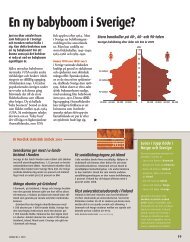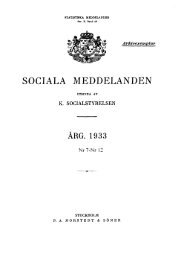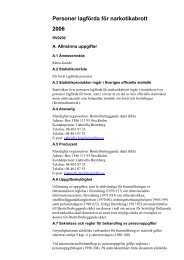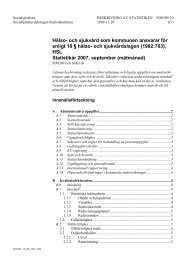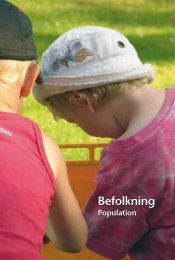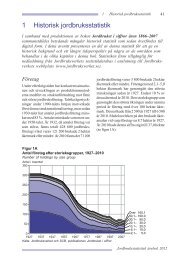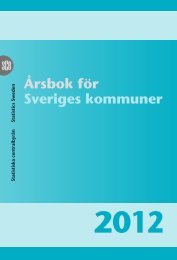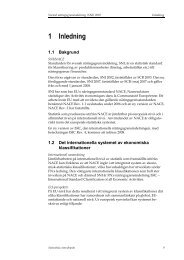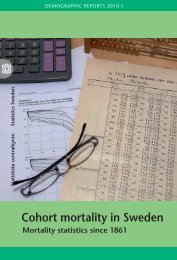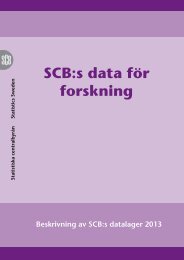Perspektiv på välfärden 2004 (pdf) - Statistiska centralbyrån
Perspektiv på välfärden 2004 (pdf) - Statistiska centralbyrån
Perspektiv på välfärden 2004 (pdf) - Statistiska centralbyrån
You also want an ePaper? Increase the reach of your titles
YUMPU automatically turns print PDFs into web optimized ePapers that Google loves.
Youth<br />
rect, as an indicator of the incidence of economic<br />
problems. The indicators are displayed in table 2.<br />
There is no discernable trend among the single<br />
indicators. Trouble making ends meet actually<br />
increases over time, while, for example, it becomes<br />
less common to borrow from family or<br />
friends in order to buy food or pay the rent. The<br />
indicators are summarized into an index, henceforth<br />
referred to as the deprivation index, which<br />
varies between zero and seven. Mean values and<br />
standard deviations are shown in table 1. The<br />
deprivation index also shows an unambiguous<br />
trend over time, decreasing between t 0 and t 1 ,<br />
thereafter increasing again at t 2 . Evaluating the<br />
degree to which this development mirrors the<br />
general economic development – t 2 being affected<br />
by the deep recession in the beginning of the<br />
1990s – or whether it reflects a life course pattern<br />
in which the worsening situation between t 1 and t 2<br />
is mainly caused by family formation and, more<br />
specifically, parenthood, is beyond the scope of<br />
this article.<br />
Income and the deprivation index constitute the<br />
outcome variables in this study. The question is<br />
what kinds of circumstances affect the outcome.<br />
A number of variables, related to the discussion<br />
above, will be introduced in the analysis. The<br />
distributions of the variables are shown in table 3<br />
and they are operationalized in the following way.<br />
Age is based on year of birth and gender on the<br />
respondent’s sex. Now, age might be seen as superfluous,<br />
as the population covers a restricted<br />
age span from the beginning. However, the age<br />
span covers a very volatile period in most people’s<br />
lives; there is usually a great difference between<br />
being 19 and being 25. Thus, age is used as<br />
a control for systematic age differences. In addition,<br />
interactions between age and the variables<br />
related to block 2 in Figure 1 have also been<br />
tested. There is, however, only one such interaction<br />
that, in the end, had a significant impact, and<br />
hence is included in the analysis; this interaction<br />
is between being a student and age.<br />
Class of origin refers to the Swedish socioeconomic<br />
classification schema (SEI). This<br />
schema is designed to identify labour market positions<br />
that have similar qualification requirements<br />
to fill the position. Respondents were asked about<br />
their parents’ main occupation during upbringing.<br />
Six different classes are identified: 1) Blue-collar<br />
workers are those who do manual labour. No distinction<br />
is made between positions that demand<br />
vocational training and those that do not. 2)<br />
Lower white-collar workers occupy a non-manual<br />
position requiring at least some secondary schooling.<br />
3) Middle white-collar workers hold positions<br />
that require at least three years of upper secondary<br />
schooling. 4) Higher white-collar workers hold<br />
positions that normally require a university de-<br />
72<br />
gree. Professional entrepreneurs, such as architects<br />
and doctors, are included in this group. Besides<br />
these four groups of employed individuals,<br />
two categories of self-employed are distinguish.<br />
Thus the fifth class is made up of all selfemployed<br />
individuals, except farmers, who form<br />
the sixth and final category. In the first panel<br />
wave only father’s occupation was asked about.<br />
However, the two subsequent waves also contain<br />
mother’s occupation. In the cases where the<br />
mother's and father’s class positions diverged, the<br />
‘highest’ class position was assigned as class of<br />
origin. If both parents were employed, this operation<br />
is relatively straightforward, following the<br />
hierarchy from blue-collar workers to higher<br />
white-collar workers. If one parent was a farmer<br />
and the other employed, class of origin is set to<br />
farmer. If one parent was self-employed, class of<br />
origin is set to self-employed, regardless of the<br />
other parent’s class position.<br />
We are not, for reasons outlined above, analysing<br />
the impact of the respondent's own class position<br />
at t . Instead we use a number of other indica-<br />
0<br />
tors regarding the youth’s situation. The first<br />
category to be differentiated is students. However,<br />
a significant share of the population had already at<br />
t completed their education, making it important<br />
0<br />
to also analyse their educational attainment. Five<br />
different educational levels are operationalized: 1)<br />
compulsory school only, 2) at most two years<br />
vocational training, 3) more than two years of<br />
secondary education, 4) at most less than three<br />
years of tertiary education and, 4) three or more<br />
years of tertiary education.<br />
Unemployment is indicated by two variables<br />
measuring unemployment experience during the<br />
past five years. The first, which will be labelled<br />
short-term unemployed, discriminates those unemployed<br />
for less than six months during the past<br />
five years, and the second, consequently called<br />
long-term unemployed, covers those unemployed<br />
more than six months during the past five years.<br />
The household situation at t is indicated by two<br />
0<br />
variables. The first one, nest leaving, differentiates<br />
between those who have left the parental<br />
home and those still living with their parents. The<br />
second, parenthood, discriminates those who have<br />
their own children. The final variable, indicating<br />
economic vulnerability, measures whether the<br />
respondent has received social assistance any time<br />
during the past twelve months 3<br />
. This variable<br />
3 From 1983 and onwards, is it possible to derive information<br />
about social assistance from the income<br />
register attached to ULF. Because this option is not<br />
available for the t0 observation in this study, the indicator<br />
is based on information from a question in ULF.<br />
Comparing the question with register data in later ULF




